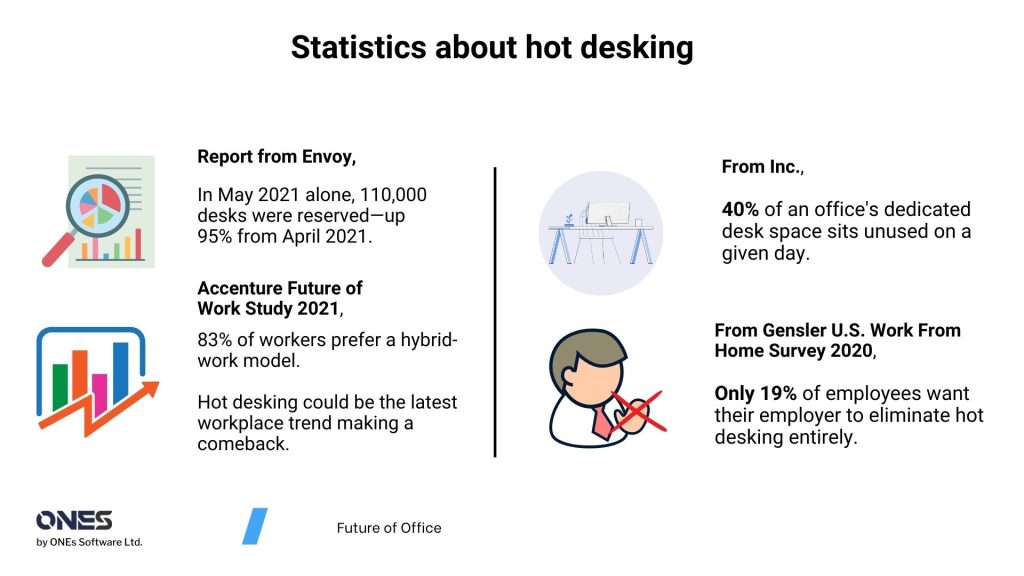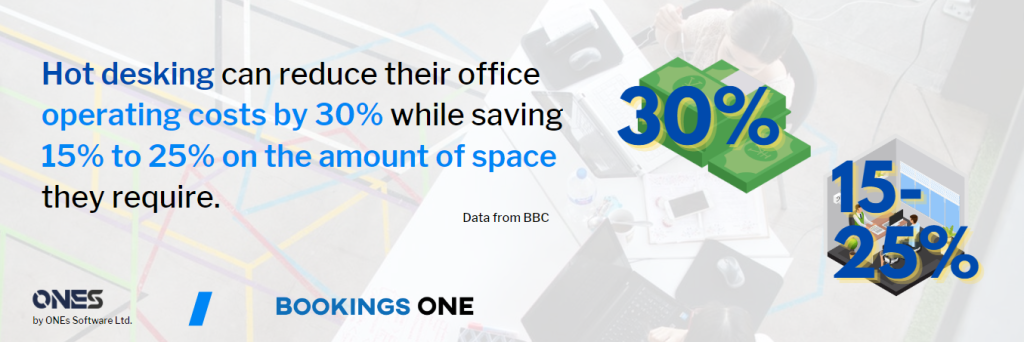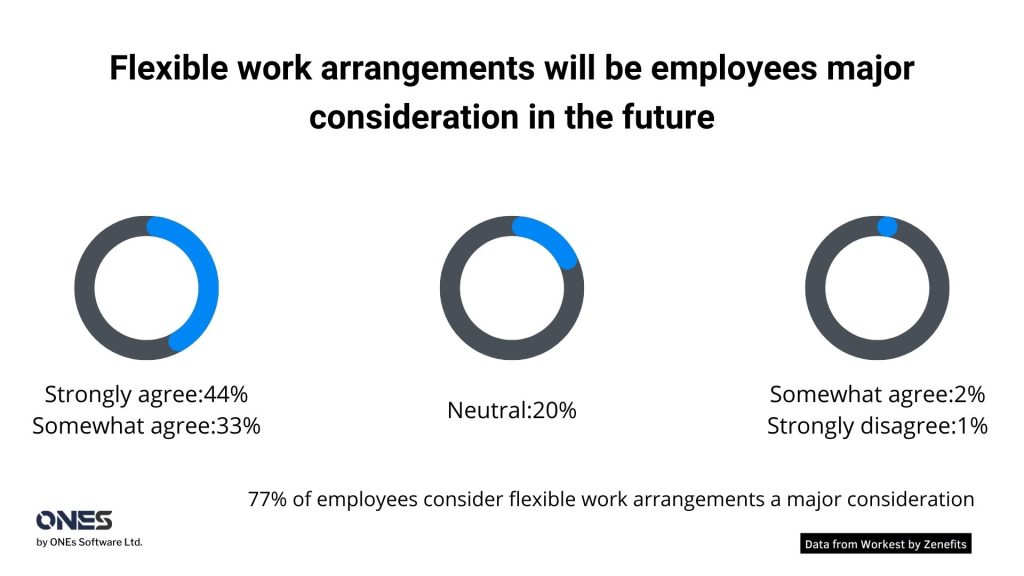As a result of the pandemic, many offices are implementing flexible working and becoming hybrid offices. The hot desk is one of the flexible working methods.
Recently, executives at Europe’s largest bank also told to try ‘Hot Desking’, noting it comes as the bank pursues plans to shrink its office space by 40% in a post-pandemic shake-up.
In this article, we will explain deeply how hot desking affect the world and why you need hot desking in the future.
Table of Contents
What is hot desking?
Hot desking is an organizational workspace system in which desks in a workspace are used on an ad-hoc basis.
Instead of having only one designated space or permanent desk, hot desking allows employees to use any available mobile desk and is a strategy that helps increase flexibility and encourages collaboration.
The benefits of using a hot desk are that it maximizes space efficiency and reduces redundant office space to save on operating expenses.

Hot desking: A major trend of the hybrid working
Hybrid working is an arrangement in which a company’s management and employees alternate between working in a physical office and working remotely. The transformation is now evolving as many firms adopt hybrid working practices to accommodate an increasingly digital-based workforce.
According to the Accenture Future of Work Study 2021, hybrid work looks set to go from strength to strength thanks to the autonomy and flexibility it offers and as 83% of workers prefer a hybrid-work model, it appears that hot desking could be the latest workplace trend making a comeback.
The report from Envoy shows a surge in employees using hot desks under the trend of hybrid working. In May 2021 alone, 110,000 desks were reserved—up 95% from April 2021.
Do you really need a hot desk?
As previously said, hot-desking is designed to boost employee flexibility and make better use of space, as well as to improve staff communication.
Employees may have the chance to meet individuals from different departments whom they would not have met otherwise, which may result in a more social workplace atmosphere and a personal connection that may enhance cross-departmental work.
However, the practice must be managed carefully. While this may be an effective solution for employees who aren’t in the office very often, there are several health and safety concerns that come from numerous people sharing a single workplace throughout the day.
For example, office workstations should be configured to meet the needs of each employee, and suitable equipment should be given. It’s also worth mentioning that there are hygiene concerns that arise when employees use the same piece of equipment, as well as psychological issues that arise when employees are separated from supervisors or colleagues.
Statistics about hot desking and flexible working
Permanent desks become unnecessary

The permanent desk is unnecessary for an office. Based on data from Inc. survey, 40% of an office’s dedicated desk space sits unused on a given day.
(Inc.)
Only a few employees need their own desks
When they return to work following the coronavirus pandemic, only 19% of employees do not want any hot desking. (Gensler U.S. Work From Home Survey 2020)

Hot desking is cost-effective

Hot desking can reduce their office operating costs by 30% while saving 15% to 25% on the amount of space they require.
(BBC)
Hot desking price drops
Indicating the growing availability of new flexible offices and how increased competition is resulting in even more inexpensive solutions for businesses and professionals, the global average price per desk decreased by 2.14% between 2019 and 2020.
Hot desking regional monthly price
The trend of falling pricing is seen in various parts of the world as the coworking sector gains popularity. Europe is the lone exception, where prices have risen by almost 12% in the previous two years.
The workspace will be consumed flexibly in the future
JLL estimates that, as a result of COVID-19’s impact on real estate and workplace management, 30% of all office space will be consumed flexibly by 2030. (JLL)
Companies decided to increase flexible workspace after the pandemic
A report by Jones Lang LaSalle, Inc (JLL) found that 37% of global organizations plan to increase their use of co-working or flex space after the pandemic. (JLL)
Employees prefer to work flexibly
Global HR and recruiting firm Adecco reported that, in the wake of COVID-19, 77% of professionals want greater flexibility in how and where they work. (Adecco)
Employees would join the flexible offices and leave the traditional offices
In a Gallup survey, 37% of employees said they would leave their current job in a traditional office to join a company that offered a flexible office environment. (Gallup).
Low efficiency of traditional office space usage
Most workplaces had vacancy rates of 20-50% prior to the coronavirus pandemic. (Work Design Magazine)
Some employees often do not work at offices before the pandemic
Half of all global employees worked outside their main office headquarters at least two and a half days per week prior to the pandemic. (IWG)
Flexible work arrangements will be employees’ major consideration in the future

77% of employees consider flexible work arrangements a major consideration when evaluating future job opportunities. (Zenefits)
Hot desking around the world
As Zenefits mentioned, 77% of people consider flexible work arrangements a major consideration. If the companies still work in traditional working methods, 37% of employees said they would leave the traditional office.
Moreover, most workplaces had vacancy rates of 20-50% prior to the coronavirus pandemic and 40% of an office’s dedicated desk space sits unused on a given day. This shows that a large workspace is unnecessary for an office and the empty permanent desks are wasting the office resources.
Therefore, if the companies become hybrid offices, it can help them to keep their talents and save the operation by reducing the workspace, while hot desking allows them to work flexibly and prevent office resources from being wasted.
Hot desking in the U.S.
Employees at Square’s San Francisco office can choose from a number of settings thanks to the office’s entirely open floor plan.
Entry-level employees can communicate with their CEO at high-top tables in an activity-based arrangement, and personnel from different departments find themselves working together much more frequently.
I love how flexible it is, and that there are always different people sitting at my desk. It makes me feel more in touch with my co-workers and what’s going on in the company.
Maja Henderson, Office Manager at Square
Hot desking in the APEC region
The Singapore Newspaper – TODAY has interviewed 10 firms, 6 firms said that they would retain their present hybrid work arrangements after the Covid 19 pandemic.
Tech firm SAP implemented a complete hot desking strategy in Singapore when it began renovating its offices in April 2021, with the goal of increasing collaboration among its 1,200 or so employees while also providing flexibility in how employees work.
Takeda Pharmaceuticals in Singapore has reduced the number of fixed workstations in order to create more meeting rooms and community spaces. Its redesigned workspaces were made available to employees at the beginning of this year.
Hot desking in Europe
The BBC notes that it comes as the bank “pursues plans to downsize its office space by 40% in a post-pandemic shake-up,” adding that “banking giant HSBC has announced that top managers in its Canary Wharf HQ have lost their desks and will have to hot-desk on an open-plan floor.”
My leadership team and I have moved to a fully open-plan floor with no designated desks,
Noel Quinn, Group Chief Executive of HSBC
In order to reduce its worldwide head office expenditures by 40%, Noel Quinn, CEO of HSBC, told the Financial Times that HSBC wasn’t renewing several of its leases in city centers that are up for renewal in the next three to five years.
Noel Quinn claimed that the idea of hot desking sprang from a genuine desire to be back in the office with everyone, mixing and exchanging ideas. He said that the bank would implement a rule requiring two personnel to work at each desk, with the exception of branches.
Other UK banks, including Lloyds and Standard Chartered, have also announced plans to dump expensive office space and offer flexible working arrangements to employees.
How does hot desking work?
The employees can reserve the desks that the employees want to use through the Office Management System. The employees can find the available desks anytime by the system.
Office Management System is a system that can manage all the desks and rooms in the office. There are lots of the best office management systems in the world, such as ONES, Envoy Desk, and Cloudbooking.
A perfect system for your hybrid office: ONES
A hybrid office should use a comprehensive office management system, which helps employees use office resources efficiently, such as rooms, desks, and office equipment, and support them to have remote work and virtual meetings with their colleagues in the office.
ONES is one of the famous all-in-one smart office systems that can help you to easily implement hybrid working at ease. You can easily perform virtual meetings, desk-hoteling, and digital office management with our Room Booking, Desk Booking, and Visitor Management features.
ONES Software now has a dedicated page to introduce a series of hybrid working measures to help you solve problems. You may wish to go to https://ones.software/hybrid-workspace/ for further reference.
Contact us: hello@ones.software, or visit ONES Software official website for more information: https://ones.software/.


